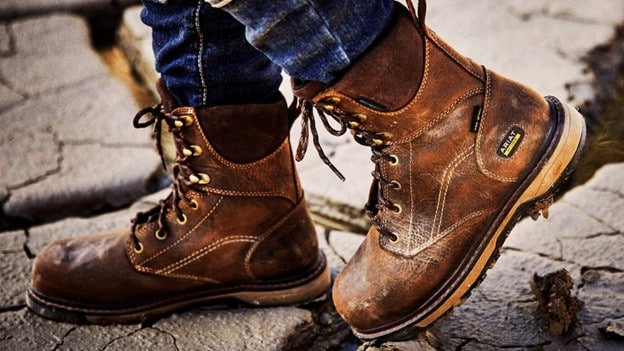Table of Contents
The skilled trades are shifting, and so are the people shaping them. With more women entering construction, manufacturing, landscaping, and other physically demanding fields, the demand for performance footwear that fits and protects them properly has never been higher. The rise of work boots for women reflects more than a trend. It’s a response to the realities of the modern workforce and a call for every gear supplier to take notice.
More Women Are Suited Up, and Boots Need to Keep Up
The number of women in trades and industrial roles has grown steadily over the past decade. Today, women represent approximately 11.2% of the construction workforce in the United States, or about 1.34 million individuals, marking a nearly 45% increase over the past decade. However, within tool-intensive roles like electricians, carpenters, and welders, representation remains low, with women comprising just 2.9%, 4.2%, and 6% of those occupations, respectively.
Industry and policy trends are supporting this shift. Targeted programs, such as WANTO grants, mentorship initiatives, and inclusive workplace changes, are actively attracting and retaining more women in the trades. As labor demand grows, apprenticeship programs expand, and inclusion efforts strengthen, women’s share in trades and industrial roles is poised to keep climbing.
But for years, many had to settle for smaller men’s sizes or unisex models that didn’t provide the right support. Women’s leather work boots and steel-toe boots for women aren’t just about smaller sizing. They’re built for different biomechanics, lower calf volume, narrower heels, and a different arch-to-ball ratio. For a welder, pipefitter, or warehouse operator, wearing boots that don’t fit properly isn’t just uncomfortable, it’s unsafe.
The Safety Gap: Why Unisex Isn’t Safe Enough
Composite toe boots for women and steel toe work boots for women are not interchangeable with scaled-down men’s models. Unisex options often overlook how poorly fit can increase trip risk, strain, and instability.
Many female safety boots now account for not just sizing but also distribution of weight, ankle support, and metatarsal protection that align with women’s foot structure. Options like women’s composite safety boots or ladies’ steel-toe work boots now close the gap between compliance and comfort. If your shoes don’t lock your heel properly or keep your midsole supported, you’re not protected. And with OSHA compliance on the line, that’s not a compromise any team can afford.
What Modern Women Expect from Their Boots
Today’s workforce demands more from their gear, and rightly so. Women’s composite toe work boots, workwear boots, and casual work boots women need in the workspace now cater to both utility and confidence. That means ergonomics that reduce fatigue, materials that withstand mud and impact, and a look that aligns with modern professional identity.
Brands now readily offer women’s work boots that blend Western durability with advanced support tech. For women in demanding environments, steel-toe boots, alloy toe work boots, and even most women’s work shoes don’t just offer style points; they offer empowerment. It’s about professional-grade gear that doesn’t force women to choose between fit and function.
Brands Are Catching Up and Customers Are Taking Note
The shift is real. Manufacturers are finally responding with appropriate work boots, including composite toe boots, and even women’s western work boots that meet ASTM safety standards. That includes ladies’ waterproof safety boots and women’s wide work boots that address real-world issues such as poor circulation, narrow toe boxes, or slick outsoles.
One contractor reported that after issuing steel-toe boots specifically designed for women, their team experienced fewer blisters, shorter break-in times, and improved morale. It’s not just the boots, it’s the message they send.
Building Inclusivity from the Ground Up
When employers provide or recommend ASTM-certified work boots for women, it signals that women are seen, supported, and expected to lead. Inclusivity isn’t just a value statement. It appears in the gear, sizing charts, and on the shelves. The continued support, provision, and attention to protective women’s work boots and women’s business boots proves this industry is changing, from the ground up.
Women’s Work Boots Need to be Comfortable
Comfort is a performance factor, especially for long-haul shifts. The most comfortable work boots for standing all day feature cushioned insoles, arch support, breathable liners, and lightweight materials. Women’s composite boots and steel-toe work boots, featuring shock-absorbing midsoles and ergonomic footbeds, significantly reduce fatigue. Brands like Ariat and Carolina offer top-tier options that combine job-rated protection with all-day wearability.
So, how do you choose between aluminum, composite, and steel-toe options? Aluminum is lighter than steel but bulkier and may transfer cold. Steel offers a slim design with high-impact resistance, but it can add weight. Composite toe boots, which women prefer, offer a balance of protection and thermal insulation, making them ideal for those on their feet in shifting environments.
Built to Meet Today’s Real Demands
Today’s workforce includes women who expect and deserve footwear designed for performance, safety, and comfort, not just scaled-down men’s boots. The rise of women’s safety boots is more than a product shift. It’s a recognition that great gear makes every job safer, stronger, and more inclusive.


